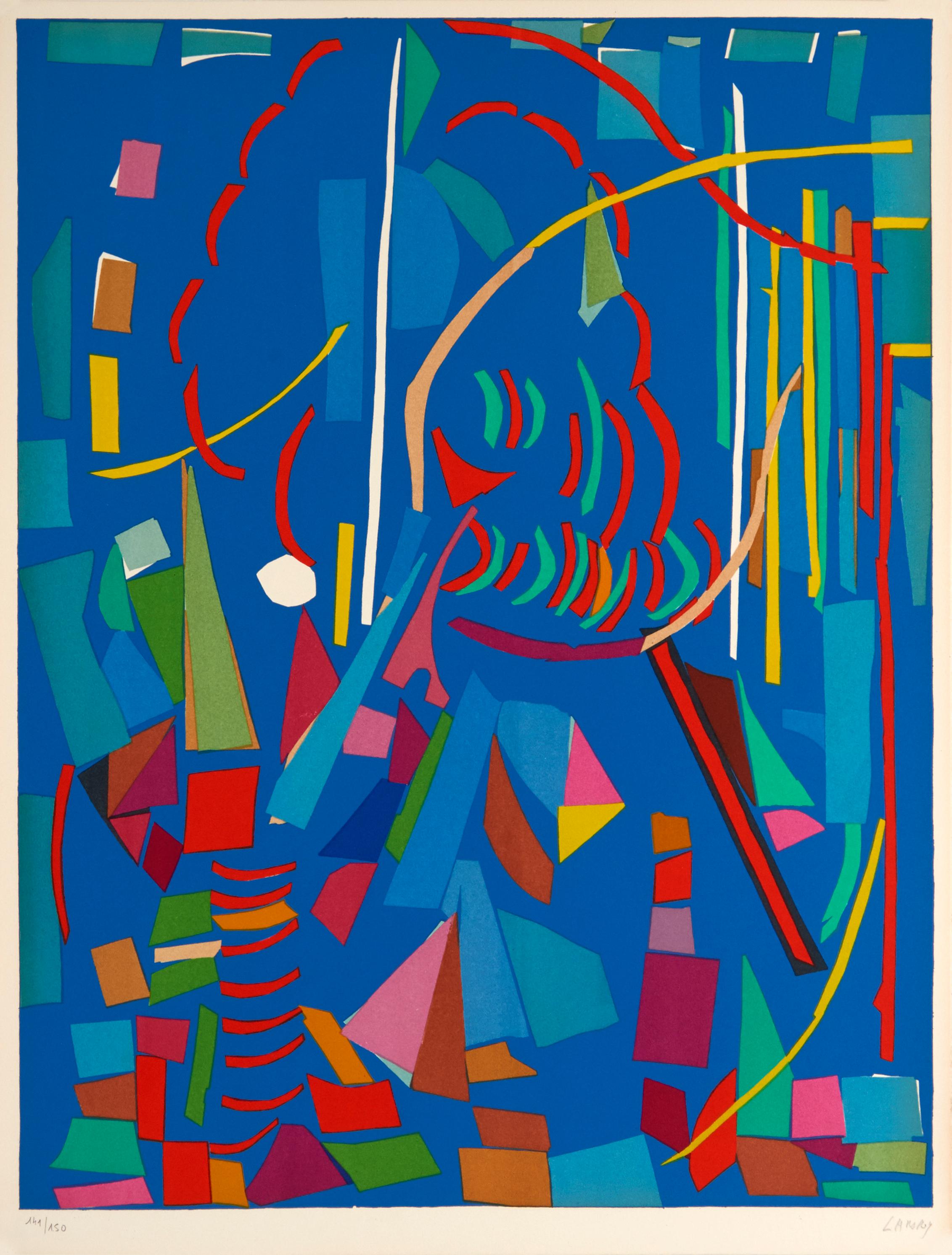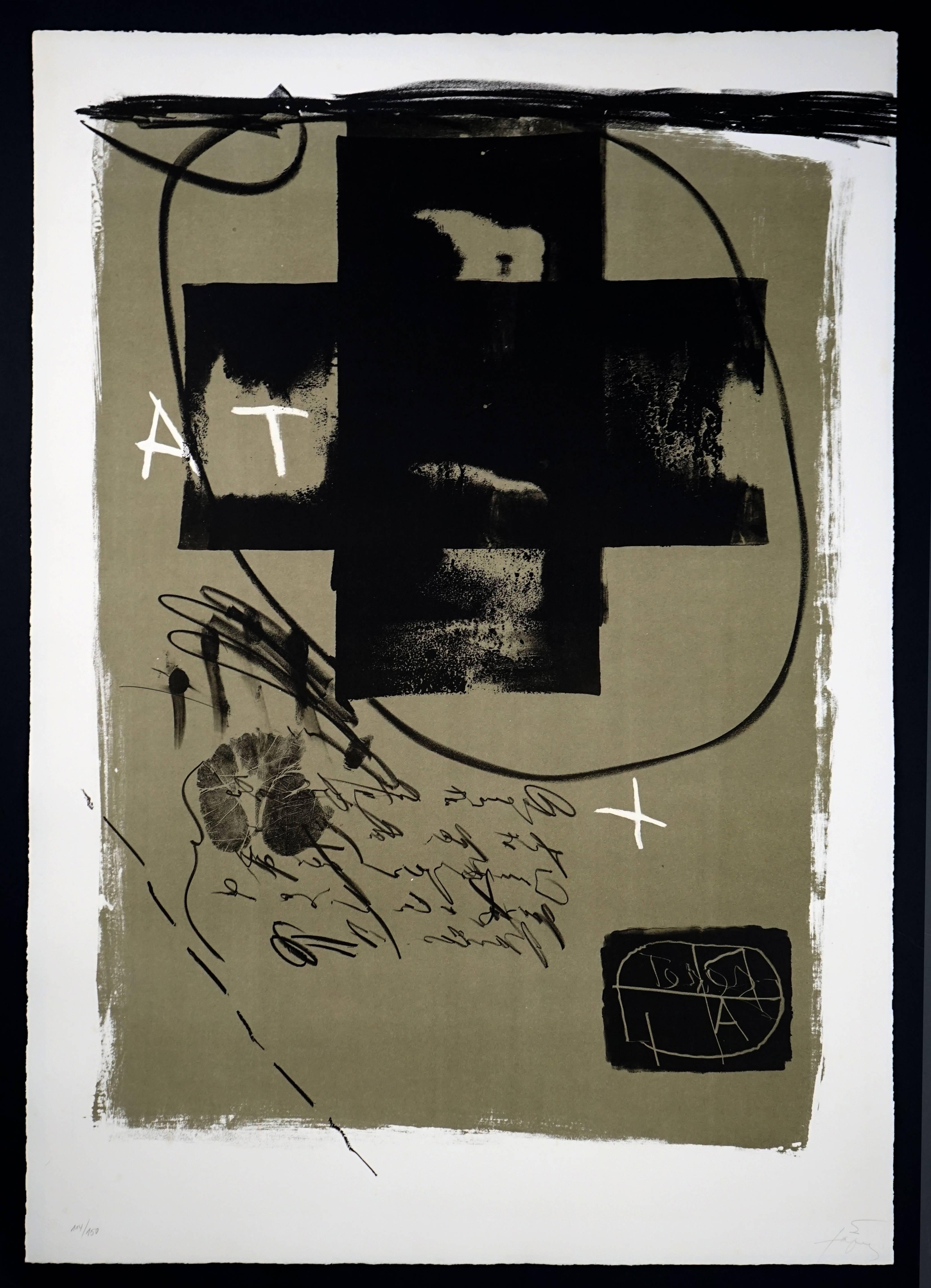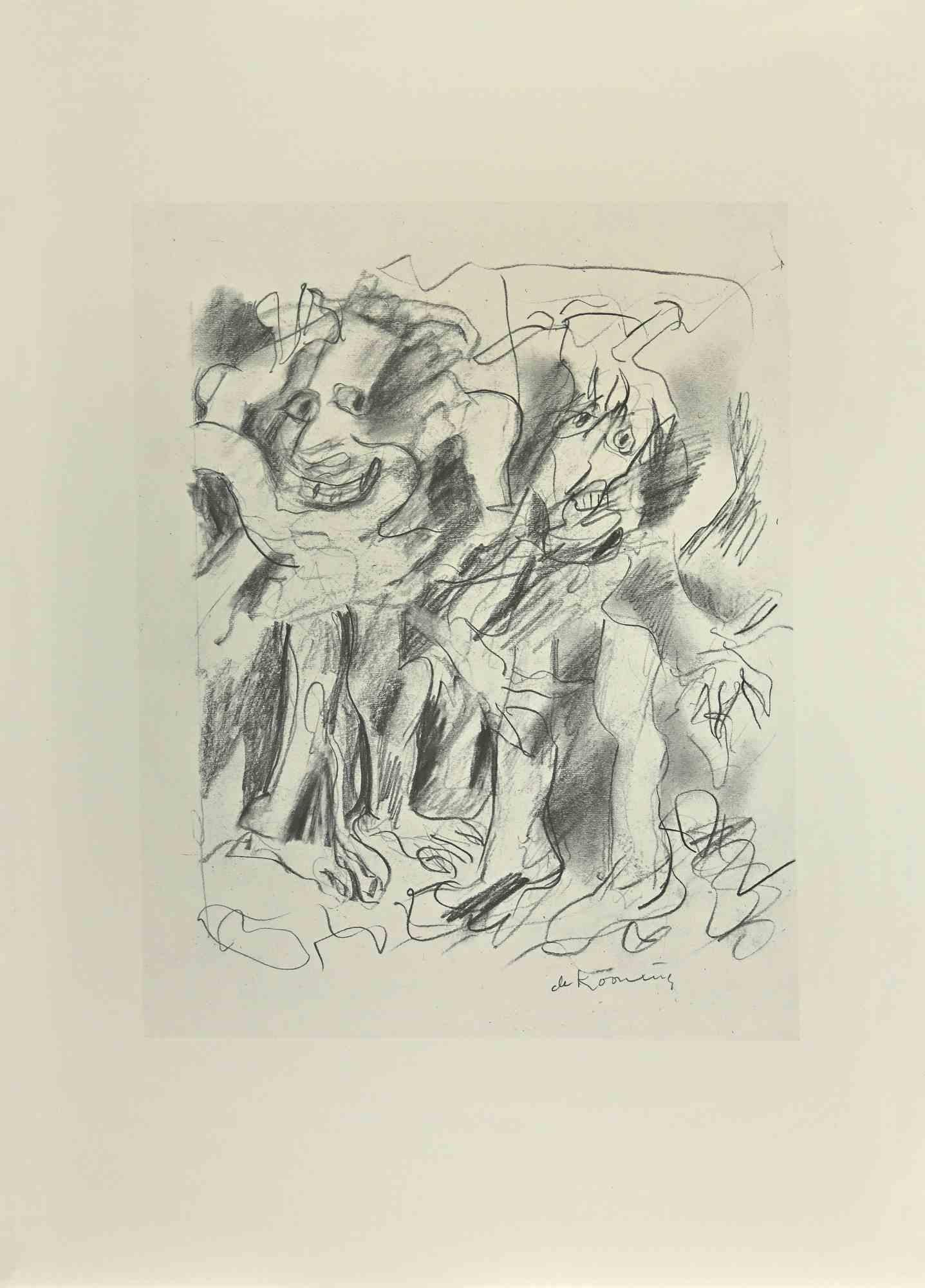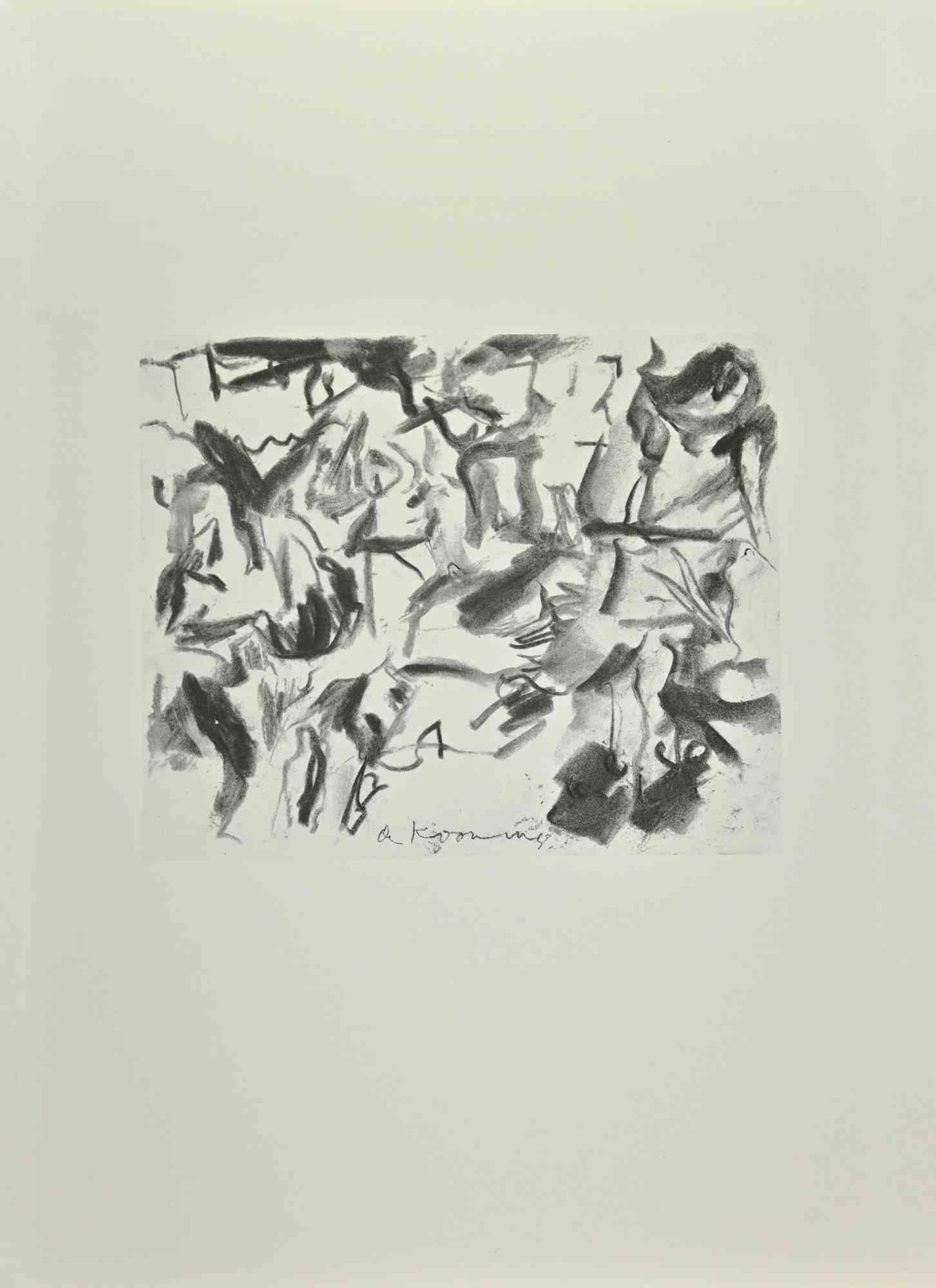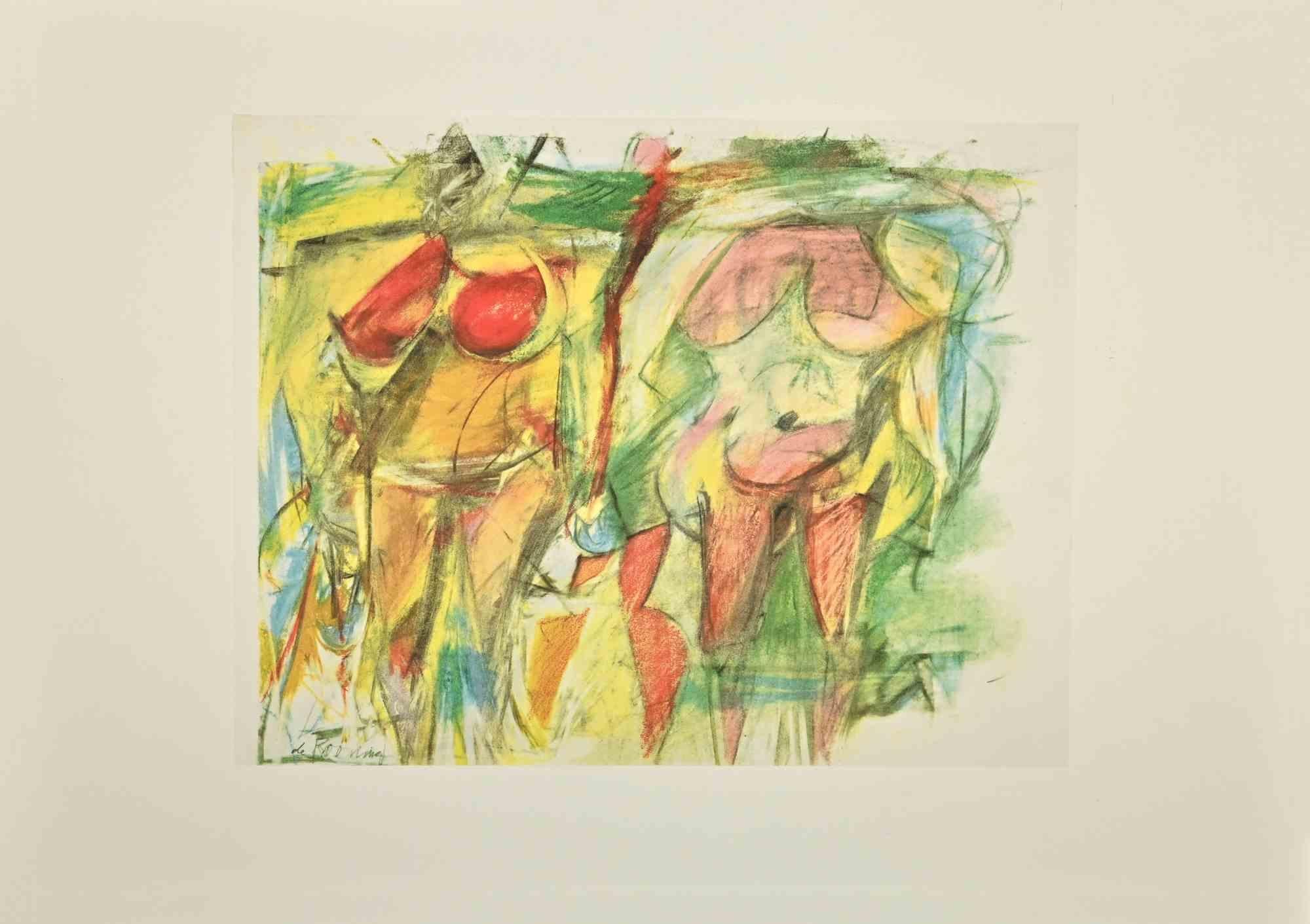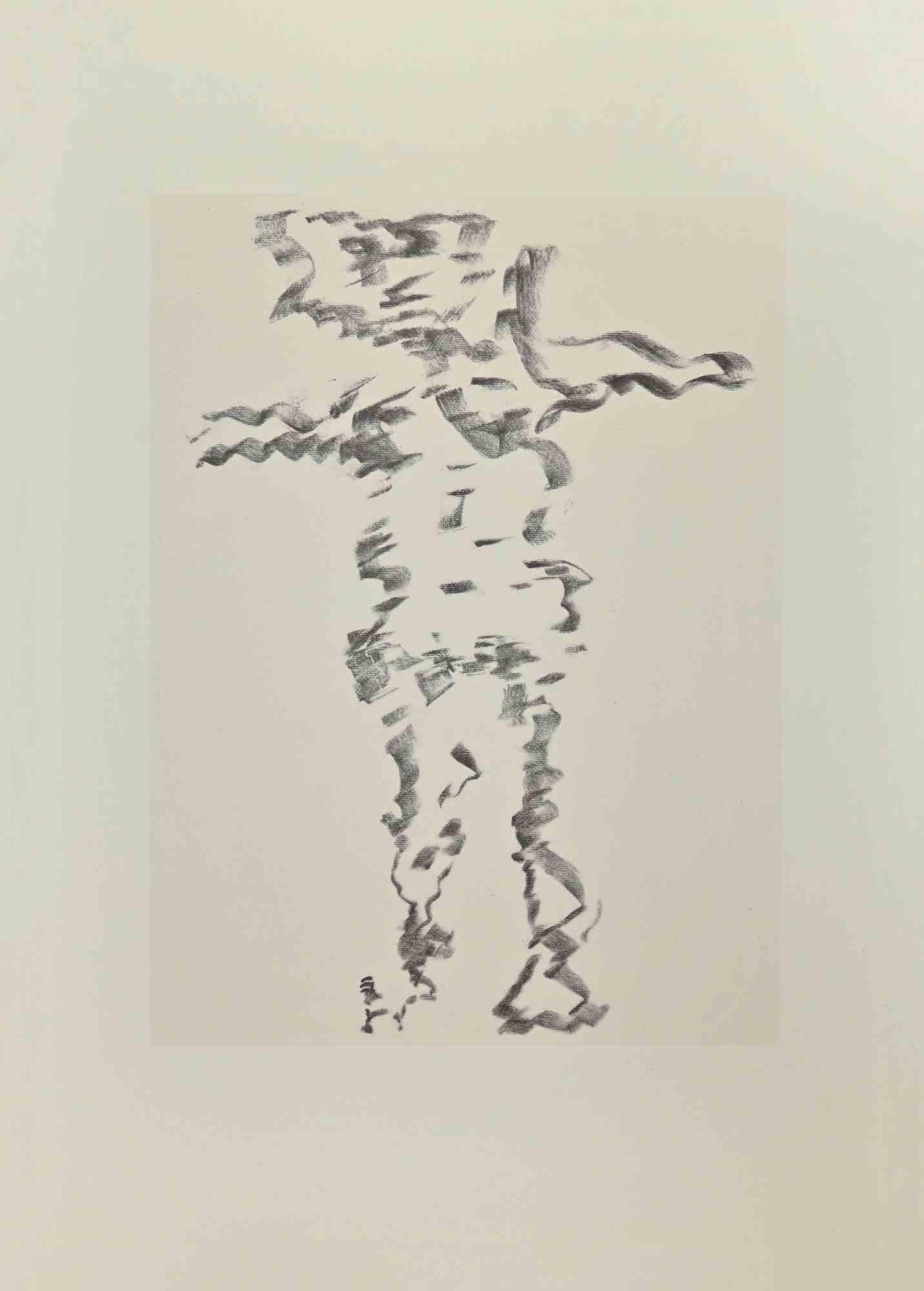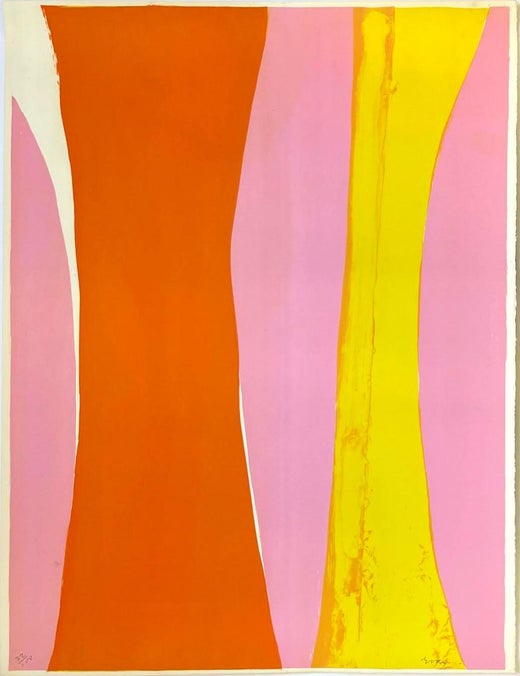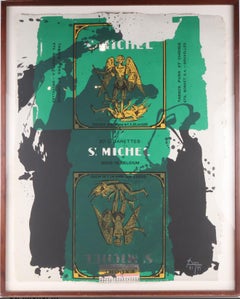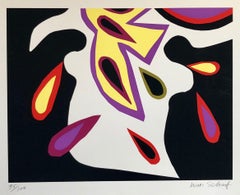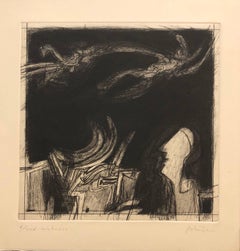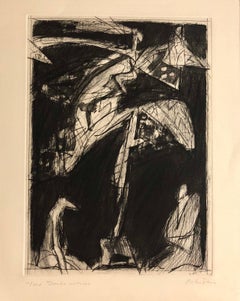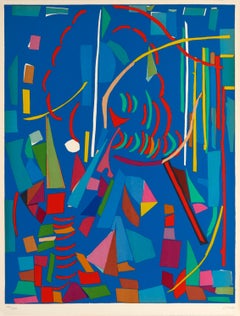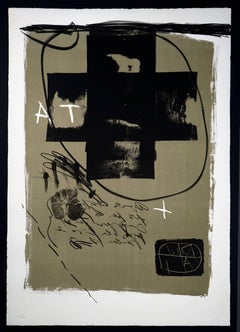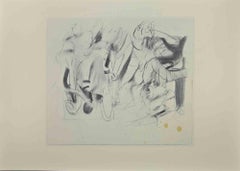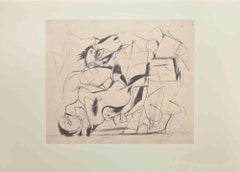Items Similar to Lyrical Abstract Expressionist Lithograph Cleve Gray Lithograph Silkscreen Print
Want more images or videos?
Request additional images or videos from the seller
1 of 10
Cleve GrayLyrical Abstract Expressionist Lithograph Cleve Gray Lithograph Silkscreen Print1976
1976
About the Item
Cleve Gray, American (1918-2004)
Composition, (1976)
serigraph or lithograph
Hand signed lower right, and editioned 36/60
Dimensions: 19.25 X 23.75 inches sheet.
unframed
Cleve Gray (1918 – 2004) was an American Abstract expressionist painter, who was also associated with Color Field painting and Lyrical Abstraction.
Gray was born Cleve Ginsberg, the family changed their name to Gray in 1936. Gray attended the Ethical Culture School in New York City (1924–1932). From the age of 11 until the age of 14 he had his first formal art training with Antonia Nell, who had been a student of George Bellows. From 15 to 18 he attended the Phillips Academy, in Andover, Massachusetts; where he studied painting with Bartlett Hayes and won the Samuel F. B. Morse Prize for most promising art student. In 1940 he graduated from Princeton University summa cum laude, with a degree in Art and Archeology. He was a member of Phi Beta Kappa. At Princeton he studied painting with James C. Davis and Far Eastern Art with George Rowley, under whose supervision he wrote his thesis on Yuan dynasty landscape painting. Best known for his calligraphic abstractions which melded elements of Abstract Expressionism, Color Field painting, and traditional Chinese scroll painting. After graduation in 1941 Gray moved to Tucson, Arizona. In Arizona he exhibited his modernist landscape paintings and still lifes at the Alfred Messer Studio Gallery in Tucson. In 1942 he returned to New York and joined the United States Army. During World War II, he served in the signal intelligence service in Britain, France and Germany, where he rose to the rank of sergeant. After the liberation of Paris he was the first American GI to greet Pablo Picasso and Gertrude Stein. He began informal art training with the French artists André Lhote and Jacques Villon, continuing his art studies in Paris after the war. Gray returned to the United States in 1946. In 1949 he moved to the house his parents had owned on a 94-acre property in Warren, Connecticut, and lived there for the rest of his life. In the 1960s he formed a close friendship with Barnett Newman. It was during this time that he experienced an artistic metamorphosis, dissolving his earlier cubist compositions in a sea of distilled color. This dramatic body of work marked the beginning of an artistic meditation that would last for over 40 years. The rigors of French modernism, the ethos of Abstract Expressionism and the meditative restraint of Chinese and Japanese scroll painting commingle with astounding affect. The atmospheric, subdued tones of his 1960s paintings gradually gave way to bright, monochromatic fields of color, hazily washed onto the canvas in stain like swathes. Much of his work from the last three decades of his career feature striking graphic brushwork that conjures the influence of Asian, Japanese and Chinese calligraphy. He married the noted author Francine du Plessix on April 23, 1957. They worked in separate studios in two outbuildings with a driveway in between. Gray was a veteran of scores of exhibitions throughout his career, as listed below, from the early days Tucson, through to postwar Paris and New York, and most recently in 2002 at the Berry-Hill Gallery in New York City. His paintings are held in the collections of numerous prominent museums and institutions. In 2009 the art critic Karen Wilkin curated a posthumous retrospective of his work at the Boca Raton Museum of Art, Florida, and other posthumous exhibitions have been held.
Museum collections
Addison Gallery of American Art, Phillips Academy, Andover, MA
Albright-Knox Art Gallery, Buffalo, New York
Boca Raton Museum of Art, Boca Raton, Florida
The Brooklyn Museum, New York City
Columbia University Art Gallery, New York City
Columbus Museum of Art, Ohio
The Corcoran Gallery of Art, Washington, D.C.
Grey Art Gallery and Study Center, New York University, New York City
Solomon R. Guggenheim Museum, New York City
Honolulu Museum of Art, Honolulu, Hawaii
The Jewish Museum, New York City
The Metropolitan Museum of Art, New York City
Museum of Art, Rhode Island School of Design, Providence
Museum of Fine Arts, Boston
Museum of Fine Arts, Houston
Museum of Modern Art, New York City
The Neuberger Museum, State University of New York at Purchase
New Britain Museum of American Art, Connecticut
The Newark Museum, New Jersey
Norton Gallery of Art, West Palm Beach, Florida
Oklahoma City Art Center, Oklahoma
The Phillips Collection, Washington, D.C.[14]
The Art Museum, Princeton University, New Jersey[6]
Rose Art Museum, Brandeis University, Waltham, Massachusetts
Sheldon Museum of Art, University of Nebraska, Lincoln
Smithsonian American Art Museum, Washington, D.C.
The Wadsworth Atheneum, Hartford, Connecticut
Whitney Museum of American Art, New York City
Yale University, New Haven, Connecticut
Williams College Museum of Art, Williamstown, Massachusetts
Yale University Art Gallery, New Haven, Connecticut
He was included in the show 1977, Group Exhibition, Betty Parsons Gallery. Mino Argento, Calvert Coggeshall, Minoru Kawabata, Richard Tuttle, Ruth Vollmer, Robert Yasuda, Helene Aylon and Cleve Gray (among others).
1978, Group Exhibition, Betty Parsons Gallery. Ruth Vollmer, Mino Argento, Cleve Gray, Calvert Coggeshall Abstraction: 1950-1970 at Taylor Graham, Greenwich CT. A survey of post-war abstract art movements including Abstract Expressionism, Color Field, Hard Edge, Minimalism and Op-Art. Adolph Gottlieb, André Cottavoz, Carl Robert Holty, Cleve Grey, Friedel Dzubas, Ilya Bolotowsky, James Hiroshi Suzuki, Norman Bluhm, Ralph Della-Volpe, Theodore Appleby and more.
- Creator:Cleve Gray (1918-2004, American)
- Creation Year:1976
- Dimensions:Height: 19.25 in (48.9 cm)Width: 23.75 in (60.33 cm)
- Medium:
- Movement & Style:
- Period:
- Condition:
- Gallery Location:Surfside, FL
- Reference Number:1stDibs: LU38214529002
Cleve Gray
Cleve Gray was an American Abstract Expressionist painter. He was born on September 22, 1918, in New York. His works are displayed in various museums including, The Brooklyn Museum, The Metropolitan Museum of Art, The Smithsonian Institute, The Whitney Museum of American Art, Museum of Modern Art, The Guggenheim Museum, Museum of Fine Arts, Boston and The Phillips Collection. Gray died on December 8, 2004, in Hartford.
About the Seller
4.9
Platinum Seller
Premium sellers with a 4.7+ rating and 24-hour response times
Established in 1995
1stDibs seller since 2014
1,745 sales on 1stDibs
Typical response time: 2 hours
- ShippingRetrieving quote...Shipping from: Surfside, FL
- Return Policy
Authenticity Guarantee
In the unlikely event there’s an issue with an item’s authenticity, contact us within 1 year for a full refund. DetailsMoney-Back Guarantee
If your item is not as described, is damaged in transit, or does not arrive, contact us within 7 days for a full refund. Details24-Hour Cancellation
You have a 24-hour grace period in which to reconsider your purchase, with no questions asked.Vetted Professional Sellers
Our world-class sellers must adhere to strict standards for service and quality, maintaining the integrity of our listings.Price-Match Guarantee
If you find that a seller listed the same item for a lower price elsewhere, we’ll match it.Trusted Global Delivery
Our best-in-class carrier network provides specialized shipping options worldwide, including custom delivery.More From This Seller
View AllLarge Abstract Expressionist Lithograph SIlkscreen Robert Motherwell St Michael
By Robert Motherwell
Located in Surfside, FL
Robert Motherwell, American, 1915-1991
St. Michel III
1979
Lithograph and Screenprint
On handmade paper
Hand signed in white pencil and numbered 71/99.
Dimensions: Sight 40 3/4 x 32 ...
Category
1970s Abstract Expressionist Abstract Prints
Materials
Lithograph, Screen
Bright Vibrant Pop Art Silkscreen Lithograph Print NYC Abstract Expressionist
By William Scharf
Located in Surfside, FL
Red Angel, intensely and seductively colored: swooning purples and reds, ecstatic lemon yellows, and black construction paper. Jostling shapes, geometric and biomorphic, lyrical and hard-edged, refuse to resolve neatly Assemblage, a bold strategy to keep viewers unsettled and curious, the reward for which are profuse and luscious details: varied incidents of refinement, suggestive signs, most in a private code, not merely ornamental but integral to the overall message.
William Scharf (born 1927, Media, PA) is an American artist from New York, he teaches at The Art Students League of New York. Painting with acrylics, he was a member of the New York School movement. Often categorized as a late generation Abstract Expressionist, Known for producing paintings with abstract compositions incorporating biomorphic and geometric forms in vivid colors, the artist was influenced by Surrealism, the Color Field painters, and symbolism.
He apprenticed with Mark Rothko and was influenced by his color field paintings. The surrealist painter Arshile Gorky and the Abstract expressionism style found in 1950s New York City also influenced Scharf. His exhibits include San Francisco Art Institute (1969), the Pepperdine University's Frederick R. Weisman Museum of Art (2001), and Richard York Gallery in New York City (2004).
In the heyday of Abstract Expressionism, being serious meant following the tenets of the New York School, which required abstract paintings to be spontaneous improvisations, the messier the better. At once hedonistic and disciplined, his brazen paintings are nothing if not promiscuous. The best ones mix the dynamism of gestural abstraction with sensual rhythms of decorative patterning, sometimes souping up the stew with cartoonish symbols and flourishes so ripe they belong in a dandy's fantasies. His exhibits include San Francisco Art Institute (1969), the Pepperdine University's Frederick R. Weisman Museum of Art (2001) and Richard York Gallery in New York City (2004).
Scharf's work has been exhibited in a number of galleries, including the Anita Shapolsky Gallery, Meredith Ward Fine Art, and Hollis Taggart Galleries in New York City.
Scharf has been an instructor of art at various institutions including The Art Students League, the San Francisco Art Institute, and the School of Visual Arts in New York. He is a member of the Society of Illustrators and the Artists Equity Association.
EDUCATION
1944-49 The Pennsylvania Academy of the Fine Arts — Philadelphia, PA (1948 Cresson Scholar)
1949 The University of Pennsylvania — Philadelphia, PA
1948 The Academie de la Grand Chaumiere — Paris, France
1947 The Barnes Foundation — Merion, PA
1939-41 Samuel Fleisher Memorial School— Philadelphia, PA (also known as Graphic Sketch Club)
TEACHING HISTORY
Instructor: Painting & Drawing
1987-Present Art Students League, New York, NY
1989, 74, 69, 66, 63 San Francisco Institute of Fine Arts, San Francisco, CA
1965-69 he School of Visual Arts, New York, NY
1964 Art Center of the Museum of Modern Art, New York, NY
Guest Lecturer
1979 Pratt Institute, New York, NY
1974 Stanford University, Palo Alto, CA
1974 California College of Arts and Crafts, San Francisco, CA
Recent Solo Exhibitions:
2005 Meredith Ward Fine Art, New York, NY
2004 Richard York Gallery, New York, NY
2002 P.S.1/MOMA, Queens, NY
2001 The Frederick R. Weisman Museum of Art, Malibu, CA
2000-2001 The Phillips Collection, Washington, DC
Selected Group Exhibitions:
2005 National Academy of Design, New York, NY
2005 Peter McPhee Fine Arts, Stone Harbor...
Category
1970s Abstract Expressionist Abstract Prints
Materials
Lithograph, Screen
Beat Artist "Witness" Lithograph Etching Lakeside Studio Chicago
Located in Surfside, FL
Will Petersen, a painter, master printer and a poet, was born in
Chicago. (Amer. 1928-1994) created this limited edition Etching on Arches paper at
the Lakeside Studio.
The LITHOGRAPH PRINT is from a limited edition of 25 (Roman Numerals),
printed in black on Arches Cover White (archival paper).
with chopmarks and blindstamps. published by The Lakeside Studio
(chopmark lower right). THE LITHOGRAPH IS SIGNED TITLED AND ANNOTATED
BY THE ARTIST in pencil EXCELLENT condition.
Will's formal art education began with classes at the Chicago Academy
of Fine Arts. As a student at the city's Steinmetz High School,
Petersen succeeded Hugh Hefner (of Playboy magazine fame) as the HS
newspaper cartoonist, the Steinmetz Star. During this time, Petersen
recovered from polio.
In 1947 Petersen enrolled at Chicago's Wilbur Wright College. While
there, he painted with oils for the first time. Two years later he
enrolled at Michigan State University where he developed a strong
interest in literature and writing and began printmaking. By 1951 he
had begun to exhibit paintings and prints nationally. A year later he
completed his master's degree.
Petersen served in the United States Army from 1952-54, spending one
year as an education specialist in Japan. This encounter with the
Japanese culture affected his entire life. He became interested in
calligraphy and Noh, classical Japanese Buddhist performance that
combines elements of drama, music and poetry. Upon completion of his
military service in Japan in 1955, Will Petersen settled in Oakland,
California, where he met some of the most active poets of the Beat
Generation: Gary Snyder, Allen Ginsberg, Jack Kerouac, Phil Whalen,
Mike McClure and others. Petersen was attracted to the group by their
intelligence and belief in Zen Buddhism.
In 1956 in his small studio in Oakland, he printed the poems of Jack
Kerouac. He attended for the first time, the reading of Ginsberg's
Howl at Six Gallery. His relationship with Gary Snyder had begun when
both were in Kyoto, Japan; later Snyder wrote for the Plucked Chicken.
Petersen returned to Japan in 1957, pursuing painting, printmaking and
writing for eight years while living in Kyoto. In 1965 he accepted a
faculty appointment at Ohio State University, teaching drawing,
painting and printmaking. Four years later Petersen took his teaching
skills to West Virginia University in Morgantown, where he
concentrated on printmaking. He taught there until 1977 when he began
publishing Plucked Chicken, a journal of art and poetry. In 1978 in
Morgantown, Petersen and his wife, Cynthia Archer, established Plucked
Chicken Press, which they later moved to Chicago and then Evanston.
Petersen operated the Press until his death on April 1, 1994.
From 1955-57 Petersen along with Mel Strawn founded the Bay Printmakers Society. He resumed exhibiting: International Color Lithography, Cincinnati Art Museum; Gravures Americaines d’aujourd’hui, Paris; & received an MFA on the GI Bill (with Nathan Oliveira) from the California College of Arts and Crafts where Richard Diebenkorn was on the faculty. Petersen meets Kerouac, Gary Snyder, Phil Whalen, Allen Ginsberg, McClure, and Rexroth. Petersen’s now famous “Stone Garden” essay is published in Evergreen Review.
1956 In storefront studio in Oakland, California, creates serigraphs
and lithographs. Prints poems of Jack Kerouac.
1961 Back in Japan, acquires a lithography press and stones and
resumes printing lithographs. Exhibits regularly with Kyoto
Printmakers.
1969 Resident lithographer at the Lakeside Studio, Lakeside, Michigan.
Prints for the first time Richard Hunt lithographs.
1978 Establishes Plucked Chicken Press in Morgantown, West Virginia.
Resident lithographer at Lakeside Studio in Michigan.
1980 Plucked Chicken Press moves to Chicago. Publishes lithographs by
Don Crouch and Art Kleinman.
1982 Publishes Blossom, a lithograph/collage by Tom Nakashima.
1983 Series I of Plucked Chicken Press is published with work by
Archer, Duckworth, Godfrey, Heagstedt, Himmelfarb, Hoff, Hunt, Martyl,
Miller, Nakashima and Petersen.
1984 Plucked Chicken Press moves to Evanston. Series II of Plucked
Chicken Press is published with works by Croydon, Ho, Archer, Torn,
Osver, Middaugh, Roseberry, Petersen, Spiess-Ferris and Hoppock.
1985 Series III of Plucked Chicken Press is published with works by
Driesbach, Hunt, Trupp, Gregor, Pattison, Conger, Evans, Weygandt,
Archer, Ho and Petersen. Prints Suite I, Northern Illinois University
Collectors Series, with lithographs by Renie Adams, David Bower, David
Driesbach, Carl Hayano and Ben Mahmoud...
Category
20th Century Abstract Expressionist Abstract Prints
Materials
Etching, Lithograph
Beat Artist "Double Witness" Lithograph Etching Lakeside Studio Chicago
Located in Surfside, FL
Will Petersen, a painter, master printer and a poet, was born in
Chicago. (Amer. 1928-1994) created this limited edition Etching on Arches paper at
the Lakeside Studio.
The LITHOGRAPH PRINT is from a limited edition of 25 (Roman Numerals),
printed in black on Arches Cover White (archival paper).
with chopmarks and blindstamps. published by The Lakeside Studio
(chopmark lower right). THE LITHOGRAPH IS SIGNED TITLED AND ANNOTATED
BY THE ARTIST in pencil EXCELLENT condition.
Will's formal art education began with classes at the Chicago Academy
of Fine Arts. As a student at the city's Steinmetz High School,
Petersen succeeded Hugh Hefner (of Playboy magazine fame) as the HS
newspaper cartoonist, the Steinmetz Star. During this time, Petersen
recovered from polio.
In 1947 Petersen enrolled at Chicago's Wilbur Wright College. While
there, he painted with oils for the first time. Two years later he
enrolled at Michigan State University where he developed a strong
interest in literature and writing and began printmaking. By 1951 he
had begun to exhibit paintings and prints nationally. A year later he
completed his master's degree.
Petersen served in the United States Army from 1952-54, spending one
year as an education specialist in Japan. This encounter with the
Japanese culture affected his entire life. He became interested in
calligraphy and Noh, classical Japanese Buddhist performance that
combines elements of drama, music and poetry. Upon completion of his
military service in Japan in 1955, Will Petersen settled in Oakland,
California, where he met some of the most active poets of the Beat
Generation: Gary Snyder, Allen Ginsberg, Jack Kerouac, Phil Whalen,
Mike McClure and others. Petersen was attracted to the group by their
intelligence and belief in Zen Buddhism.
In 1956 in his small studio in Oakland, he printed the poems of Jack
Kerouac. He attended for the first time, the reading of Ginsberg's
Howl at Six Gallery. His relationship with Gary Snyder had begun when
both were in Kyoto, Japan; later Snyder wrote for the Plucked Chicken.
Petersen returned to Japan in 1957, pursuing painting, printmaking and
writing for eight years while living in Kyoto. In 1965 he accepted a
faculty appointment at Ohio State University, teaching drawing,
painting and printmaking. Four years later Petersen took his teaching
skills to West Virginia University in Morgantown, where he
concentrated on printmaking. He taught there until 1977 when he began
publishing Plucked Chicken, a journal of art and poetry. In 1978 in
Morgantown, Petersen and his wife, Cynthia Archer, established Plucked
Chicken Press, which they later moved to Chicago and then Evanston.
Petersen operated the Press until his death on April 1, 1994.
From 1955-57 Petersen along with Mel Strawn founded the Bay Printmakers Society. He resumed exhibiting: International Color Lithography, Cincinnati Art Museum; Gravures Americaines d’aujourd’hui, Paris; & received an MFA on the GI Bill (with Nathan Oliveira) from the California College of Arts and Crafts where Richard Diebenkorn was on the faculty. Petersen meets Kerouac, Gary Snyder, Phil Whalen, Allen Ginsberg, McClure, and Rexroth. Petersen’s now famous “Stone Garden” essay is published in Evergreen Review.
1956 In storefront studio in Oakland, California, creates serigraphs
and lithographs. Prints poems of Jack Kerouac.
1961 Back in Japan, acquires a lithography press and stones and
resumes printing lithographs. Exhibits regularly with Kyoto
Printmakers.
1969 Resident lithographer at the Lakeside Studio, Lakeside, Michigan.
Prints for the first time Richard Hunt lithographs.
1978 Establishes Plucked Chicken Press in Morgantown, West Virginia.
Resident lithographer at Lakeside Studio in Michigan.
1980 Plucked Chicken Press moves to Chicago. Publishes lithographs by
Don Crouch and Art Kleinman.
1982 Publishes Blossom, a lithograph/collage by Tom Nakashima.
1983 Series I of Plucked Chicken Press is published with work by
Archer, Duckworth, Godfrey, Heagstedt, Himmelfarb, Hoff, Hunt, Martyl,
Miller, Nakashima and Petersen.
1984 Plucked Chicken Press moves to Evanston. Series II of Plucked
Chicken Press is published with works by Croydon, Ho, Archer, Torn,
Osver, Middaugh, Roseberry, Petersen, Spiess-Ferris and Hoppock.
1985 Series III of Plucked Chicken Press is published with works by
Driesbach, Hunt, Trupp, Gregor, Pattison, Conger, Evans, Weygandt,
Archer, Ho and Petersen. Prints Suite I, Northern Illinois University
Collectors Series, with lithographs by Renie Adams, David Bower, David
Driesbach, Carl Hayano and Ben Mahmoud...
Category
20th Century Abstract Expressionist Abstract Prints
Materials
Etching, Lithograph
Color Embossed Lithograph Print New York Abstract Expressionist Woman Artist
By Amaranth Ehrenhalt
Located in Surfside, FL
This print depicts a non-objective composition of organic shapes rendered in vibrant hues of color upon a field of white.
Hand signed by artist in pencil lower right. Title and numb...
Category
20th Century Abstract Expressionist Abstract Prints
Materials
Color, Lithograph
Pietro Consagra Italian Mod Abstract Expressionist Forma Brutalist Lithograph
By Pietro Consagra
Located in Surfside, FL
Pietro Consagra (Italian, 1920-2005).
Hand signed in pencil and numbered limited edition color lithograph on Magnani paper.
Embossed stamp with limited edition numbers in pencil to lower left, and having artist pencil signature to lower right.
(from a limited edition of 80 with 15 artist's proofs)
Published by Stamperia 2RC, Rome Italy and Marlborough Gallery, Rome, Italy.
Abstract Modernist work in colors, produced in the style of the Forma art movement of Postwar Italy, of which the artist was a prominent member.
Pietro Consagra (1920 – 2005) was an Italian Post war artist working in painting, printmaking and sculpture. In 1947 he was among the founding members of the Forma 1 group of artists, proponents of structured abstraction.
Consagra was born on 6 October 1920 in Mazara del Vallo, in the province of Trapani in south-western Sicily, to Luigi Consagra and Maria Lentini. From 1931 he enrolled in a trade school for sailors, studying first to become a mechanic, and later to become a captain. In 1938 he moved to Palermo, where he enrolled in the liceo artistico; despite an attack of tuberculosis, he graduated in 1941, and in the same year signed up at the Accademia di Belle Arti, where he studied sculpture under Archimede Campini. After the Invasion of Sicily and the Allied occupation of Palermo in 1943, Consagra found work as a caricaturist for the American Red Cross club of the city; he also joined the Italian Communist Party. Early in 1944, armed with a letter of introduction from an American officer, he travelled to Rome. There he came into contact with the Sicilian artist Concetto Maugeri, and through him with Renato Guttuso, who was also Sicilian and who introduced him to the intellectual life of the city and to other postwar artists such as Leoncillo Leonardi, Mario Mafai and Giulio Turcato. Consagra signed up at the Accademia di Belle Arti di Roma in September 1944 and studied sculpture there under Michele Guerrisi, but left before completing his diploma.
In 1947, with Carla Accardi, Ugo Attardi, Piero Dorazio, Mino Guerrini, Achille Perilli, Antonio Sanfilippo and Giulio Turcato, Consagra started the artist's group Forma 1, which advocated both Marxism and structured abstraction.
Steadily Consagra's work began to find an audience. Working primarily in metal, and later in marble and wood, his thin, roughly carved reliefs, began to be collected by Peggy Guggenheim and other important patrons of the arts. He showed at the Venice Biennale eleven times between 1950 and 1993, and in 1960 won the sculpture prize at the exhibition. During the 1960s he was associated with the Continuità group, an offshoot of Forma I, and in 1967 taught at the School of Arts in Minneapolis. Large commissions allowed him to begin working on a more monumental scale, and works of his were installed in the courtyard of the Foreign Ministry in Rome and in the European Parliament, Strasbourg. His work is found in the collections of The Tate Gallery, London, in Museo Cantonale d'Arte of Lugano and the Museum of Modern Art, Paris, and the National Gallery of Art in Washington, D.C..
Consagra returned to Sicily where he sculpted a number of significant works during the 1980s. With Senator Ludovico Corrao, he helped created an open-air museum in the new town of Gibellina, after the older town had been destroyed in the earthquake of 1968. Consagra designed the gates to the town's entrance, the building named "Meeting" and the gates to the cemetery, where he was later buried.
In 1952 Consagra published La necessità della scultura ("the need for sculpture"), a response to the essay La scultura lingua morta ("sculpture, a dead language"), published in 1945 by Arturo Martini. Other works include L'agguato c'è ("the snare exists", 1960), and La città frontale ("the frontal city", 1969). His autobiography, Vita Mia, was published by Feltrinelli in 1980. In 1989 a substantial retrospective exhibition of work by Consagra was shown at the Galleria Nazionale d'Arte Moderna in Rome; in 1993 a permanent exhibition of his work was installed there. In 1991 his work was shown in the Hermitage Museum in St. Petersburg. In 2002 the Galerie der Stadt Stuttgart opened a permanent exhibition of his work. He was one of ten artists invited by Giovanni Carandente, along with David Smith, Alexander Calder, Arnaldo Pomodoro, Lynn Chadwick, and Beverly Pepper, to fabricate works in Italsider factories in Italy for an outdoor exhibition, "Sculture nella città", held in Spoleto during the summer of 1962. He was included in the The 1962 International Prize for Sculpture the jury included Argan, Romero Brest and James Johnson Sweeney the former director of the Solomon R. Guggenheim Museum in New York. The participants included Louise Nevelson and John Chamberlain for the United States; Lygia Clark for Brazil; Pietro Consagra, Lucio Fontana, Nino Franchina, and Gió Pomodoro for Italy; Pablo Serrano for Spain; and Eduardo Paolozzi, William Turnbull, and Kenneth Armitage for England. Gyula Kosice, Noemí Gerstein, Julio Gero, Naum Knop...
Category
1960s Abstract Expressionist Abstract Prints
Materials
Lithograph
You May Also Like
Blue Composition by Andre Lanskoy
By André Lanskoy
Located in New York, NY
This lithograph was printed in 1965 at the Atelier Mourlot in Paris. It is signed, and numbered from an edition of 150. A major theme running through Lanskoy's work is the interactio...
Category
1960s Abstract Expressionist Abstract Prints
Materials
Lithograph
Art 6 '75
By Antoni Tàpies
Located in Austin, TX
Artist: Antoni Tapies
Title: Art 6 '75
Year: 1975
Medium: Lithograph
Signed and numbered 114/150 bottom left with publisher's blindstamp
In excellent condition.
Dimensions: 35.25 x ...
Category
1980s Abstract Expressionist Abstract Prints
Materials
Lithograph
$1,987 Sale Price
25% Off
Figures with Bicycle- Offset and Lithograph after Willem De Kooning - 1985
By Willem de Kooning
Located in Roma, IT
Figures with Bicycle is an offset and lithograph print realized on Fabriano Paper after a drawing by Willem De Kooning of 1965.
The print suite was realized in 1985 in a limited edi...
Category
1980s Abstract Expressionist Abstract Prints
Materials
Lithograph, Offset
Untitled- Offset and Lithograph after Willem De Kooning - 1985
By Willem de Kooning
Located in Roma, IT
Untitled is an offset and lithograph print realized on Fabriano Paper after a drawing by Willem De Kooning 1950.
The print suite was realized in 1985 in a limited edition of 2500, a...
Category
1980s Abstract Expressionist Abstract Prints
Materials
Lithograph, Offset
Figures in Interior - Offset and Lithograph after Willem De Kooning - 1985
By Willem de Kooning
Located in Roma, IT
Figures in Interior is an offset and lithograph print realized on Fabriano Paper after a drawing by Willem De Kooning of 1955.
Signed o the plate on the lower.
The print suite was...
Category
1980s Abstract Expressionist Abstract Prints
Materials
Lithograph, Offset
Spoleto - Offset and Lithograph after Willem De Kooning - 1985
By Willem de Kooning
Located in Roma, IT
Spoleto is an offset and lithograph print realized on Fabriano Paper after a drawing by Willem De Kooning of 1970.
The print suite was realized in 1985 in a limited edition of 2500,...
Category
1980s Abstract Expressionist Abstract Prints
Materials
Lithograph, Offset
Recently Viewed
View AllMore Ways To Browse
French China Service
Yuan Dynasty
Dynasty 1950
Carl Rose
Alfred Parsons
Rowley Design
Roy M Steinberg
Roy Wilhelm
Rupert Alexander
Saint Laurent Jerry Box
Sally Hepler On Sale
Salvador Dali Daum Nancy Glass Plate
Salvador Dali Divine Comedy Canto 26
Salvador Dali Icarus
Salvador Dali Jesus On The Cross
Salvador Dali Lincoln
Salvador Dali The Alps
Salvador Dali The Businessman
